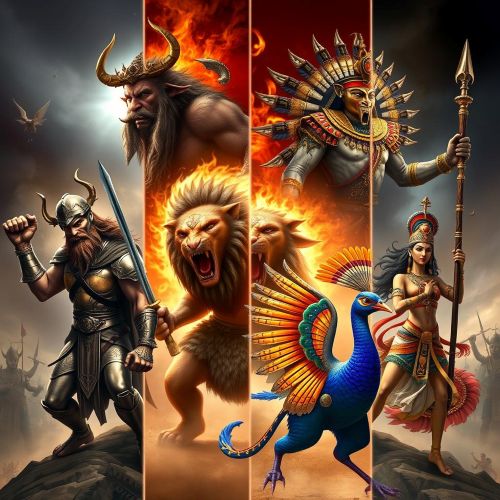Ti’iti’i : The Firebringer
Listen
At a glance
| Description | |
|---|---|
| Origin | Samoan Mythology |
| Classification | Demigods |
| Family Members | N/A |
| Region | Samoan Islands |
| Associated With | Bringing fire to humans, Trickery, Shapeshifting |
Ti’iti’i
Introduction
In Samoan mythology, Tiʻitiʻi Atalaga emerges as a powerful and enigmatic figure. Often compared to the Polynesian demigod Maui, Tiʻitiʻi embodies the archetype of the trickster hero, a cunning and resourceful individual who challenges the status quo for the betterment of humanity. Celebrated for his extraordinary feats and contributions to Samoan culture, Tiʻitiʻi is depicted in stories that highlight his bravery, intelligence, and supernatural abilities. His legend is intricately woven into the fabric of Samoan tradition, offering insights into the values, beliefs, and worldviews of the Samoan people.
Physical Traits
Detailed descriptions of Ti’iti’i’s physical appearance are scarce in Samoan legends. However, based on the broader Polynesian concept of Maui, he is often depicted as a strong and imposing figure, sometimes youthful and handsome, reflecting his demigod heritage. Tiʻitiʻi possesses an otherworldly allure that resonates with the volcanic landscapes and lush forests of Samoa. His eyes, perhaps, hold the secrets of fire itself. Attributes in Samoan mythology emphasize his divine heritage and heroic status. Typically portrayed as young, strong, and handsome, he exudes both physical prowess and an aura of authority. His exceptional strength allows him to perform incredible feats beyond the capabilities of ordinary humans, complemented by his agility and dexterity. Ti’iti’i’s appearance is often highlighted with traditional Samoan tattoos, symbolizing his cultural heritage and personal achievements.
Family
Ti’iti’i’s lineage is a crucial element of his legend, connecting him to the divine and the earthly. He is the son of Talaga, a significant deity in Samoan mythology, and Maʻatūtala, the goddess of the sea. This heritage grants him a unique combination of celestial power and earthly connection. Some accounts add complexity to his background, suggesting that he was cast out by his mother following a premature birth but was later saved by the sea and raised by benevolent ancestors. This early adversity shapes his rebellious spirit and drive to prove himself. Ti’iti’i’s family ties bridge the realms of gods and mortals, influencing his adventures and the challenges he encounters. His lineage enhances his status among other demi-gods and heroes, underscoring his extraordinary abilities and divine origins.
Other names
Tiʻitiʻi is known by various names and titles, each highlighting different aspects of his character and the roles he plays in diverse stories. One prominent alternative name is Tiʻitiʻi-a-Talaga, which links him to his father and emphasizes his heritage. These names are not just identifiers but reflect the respect and reverence Tiʻitiʻi commands within Samoan culture and the narrative complexity of his myth. In Polynesia, the trickster demigod appears under multiple names, with Tiʻitiʻi being the most recognized in Samoa. Variations such as Tiʻitiʻe and Tiʻitiīga reflect the fluidity of oral tradition and pronunciation differences in Samoan dialects. The name “Māui” also surfaces in some Samoan legends, underscoring the interconnectedness of Polynesian mythology. Linguistic nuances across the Pacific reveal similar figures, such as Gilbert Islands’ ‘Tiki-tiki’ and Hawai’ian ‘Maui-ki’i-ki’i,’ weaving a celestial thread that links distant shores.
Powers and Abilities
Ti’iti’i’s defining moment unfolds during an epic confrontation with Mafuiʻe, the god of earthquakes. Their clash reverberates through the underworld, where Mafuiʻe resides. In a bold maneuver, Tiʻitiʻi severs one of Mafuiʻe’s arms, compelling the god to reveal the secret of fire. This pivotal act establishes Tiʻitiʻi as the firebringer, a figure who bestows warmth and sustenance upon the Samoan people.
Ti’iti’i’s legend is marked by his remarkable abilities, including superhuman strength, sharp intellect, and cunning. His strength allows him to accomplish feats beyond human capability, often showcased in battles with mythological adversaries. His intellectual prowess and strategic thinking enable him to outwit opponents and overcome formidable challenges, demonstrating his role as both a protector and hero.
Among his notable achievements, the acquisition of fire for humanity is particularly celebrated. By overcoming Mafuiʻe and extracting the hidden fire from sacred trees, Tiʻitiʻi provided essential warmth and cooking capabilities to the people. This act underscores his role as a cultural hero whose actions have had a lasting impact, cementing his place in Samoan mythology as a benefactor and a figure of great significance.
Modern Day Influence
Ti’iti’i’s legacy remains vibrant in contemporary Samoan culture, embodying themes of resilience, creativity, and enlightenment. His story continues to inspire through cultural ceremonies, educational settings, and artistic expressions, ensuring that his impact endures across generations. Beyond Samoa, Ti’iti’i’s narrative contributes to a broader appreciation of Polynesian mythology, showcasing the enduring power of myth to convey cultural values and inspire individuals globally.
In modern contexts, Ti’iti’i’s influence is evident in various forms of cultural expression. His image is a prominent motif in Samoan tattoo art (tatau), symbolizing cultural identity and the values he represents. Additionally, his tales are preserved in literature and storytelling, bridging traditional knowledge with contemporary audiences. Artisans also keep his legend alive through wood carvings and other artworks, honoring his role in Samoan heritage.
Ti’iti’i’s story resonates with universal themes of resistance and the quest for knowledge, making it relevant in today’s world. His rebellious spirit and challenge to authority align with contemporary movements for social justice and cultural preservation, serving as a symbol of inspiration for those advocating for positive change.
Related Images
Frequently Asked Questions
What is lorem Ipsum?
I am text block. Click edit button to change this text. Lorem ipsum dolor sit amet, consectetur adipiscing elit. Ut elit tellus, luctus nec ullamcorper mattis, pulvinar dapibus leo.
What is lorem Ipsum?
I am text block. Click edit button to change this text. Lorem ipsum dolor sit amet, consectetur adipiscing elit. Ut elit tellus, luctus nec ullamcorper mattis, pulvinar dapibus leo.
What is lorem Ipsum?
I am text block. Click edit button to change this text. Lorem ipsum dolor sit amet, consectetur adipiscing elit. Ut elit tellus, luctus nec ullamcorper mattis, pulvinar dapibus leo.
What is lorem Ipsum?
I am text block. Click edit button to change this text. Lorem ipsum dolor sit amet, consectetur adipiscing elit. Ut elit tellus, luctus nec ullamcorper mattis, pulvinar dapibus leo.
What is lorem Ipsum?
I am text block. Click edit button to change this text. Lorem ipsum dolor sit amet, consectetur adipiscing elit. Ut elit tellus, luctus nec ullamcorper mattis, pulvinar dapibus leo.




